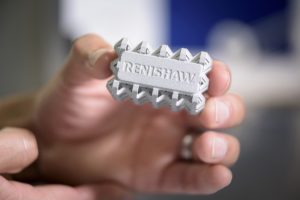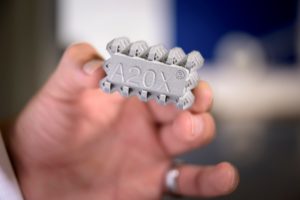The material in question, A20X, is billed as a family of next-generation high-strength aluminum alloy technologies. Aeromet and Renishaw will be working together to establish process parameters and material properties for the material, focusing on its use in additive manufacturing. The collaboration is intended to optimize the processing techniques for A20X materials on Renishaw’s 3D printers, as well as exploring heat treatment processes to further optimize properties in parts 3D printed using the aluminum-copper alloy developed by Aeromet.
“Renishaw’s metal AM systems feature high power lasers, an inert processing environment and open parameters, making them ideal for supporting innovative new materials like A20X,” said Marc Saunders, Director of Global Solutions Centres at Renishaw. “We are working closely with Aeromet to qualify this exciting new alloy on our machines. Through our network of AM Solutions Centres, we can help manufacturers to develop industrial AM processes using A20X.”
In the A20X family, AM205 is a powder created for additive manufacturing, while A205 is a Metallic Materials Properties Development and Standardisation (MMPDS) approved casting alloy. According to Aeromet, A20X has “a highly refined microstructure and a unique solidification mechanism, giving it greater strength, fatigue and thermal characteristics compared to other alloys.”
The alloy debuted at the recent Paris Air Show, and the just-announced collaboration is set to drive its development further specifically for additive manufacturing. Its roots at the AM-heavy air show showcase its viability for aerospace use, among other demanding applications.
“A20X is being rapidly adopted for additive manufacture of aero engine, airframe, space, defence and automotive parts,” said Mike Bond, Director of AMT, a division of Aeromet. “Its unique combination of high strength, high ductility and performance at high operating temperatures make it ideal for light-weight, stressed components. We look forward to making processing techniques for this innovative alloy more widely available to accelerate its adoption.”
- Renishaw metal 3D printed part. [Image: Aeromet (c) Monty Rakusen]
- [Image: Aeromet]
A20X has been brought into use through a contract with Boeing, and Aeromet ultimately expects that the alloy will become enough of a focus to be spun off into its own business. As Aeromet works with Renishaw to establish 3D printing parameters for the material, the companies are looking to release processing techniques and material properties to customers “in the coming months.”
The A20X powder for additive manufacturing applications was developed to offer high strength and superior flowability, allowing for the creation of complex, strong aluminum parts. While Aeromet is working now specifically with Renishaw to define 3D printing parameters, the powder was designed to be printable using “a wide range of leading additive manufacturing machines,” leaving the door open for wider use.
 Among the differentiating factors of A20X (both powder and casting alloy) are, according to Aeromet:
Among the differentiating factors of A20X (both powder and casting alloy) are, according to Aeromet:
- Strength
- Fatigue
- Corrosion Resistance
- High Temperature Performance
- Castability
- Flowability
- Superplasticity
Benefits of the material, as Aeromet explains, include:
- Cost Reduction
- Weight Reduction
- Thermal Performance
What do you think of this collaboration? Let us know in the Renishaw Aeromet forum thread at 3DPB.com.
Subscribe to Our Email Newsletter
Stay up-to-date on all the latest news from the 3D printing industry and receive information and offers from third party vendors.
You May Also Like
Precision at the Microscale: UK Researchers Advance Medical Devices with BMF’s 3D Printing Tech
University of Nottingham researchers are using Boston Micro Fabrication‘s (BMF) 3D printing technology to develop medical devices that improve compatibility with human tissue. Funded by a UK grant, this project...
3D Printing Webinar and Event Roundup: April 21, 2024
It’s another busy week of webinars and events, starting with Hannover Messe in Germany and continuing with Metalcasting Congress, Chinaplas, TechBlick’s Innovation Festival, and more. Stratasys continues its advanced training...
3D Printing Webinar and Event Roundup: March 17, 2024
It’s another busy week of webinars and events, including SALMED 2024 and AM Forum in Berlin. Stratasys continues its in-person training and is offering two webinars, ASTM is holding a...
3D Printed Micro Antenna is 15% Smaller and 6X Lighter
Horizon Microtechnologies has achieved success in creating a high-frequency D-Band horn antenna through micro 3D printing. However, this achievement did not rely solely on 3D printing; it involved a combination...

































